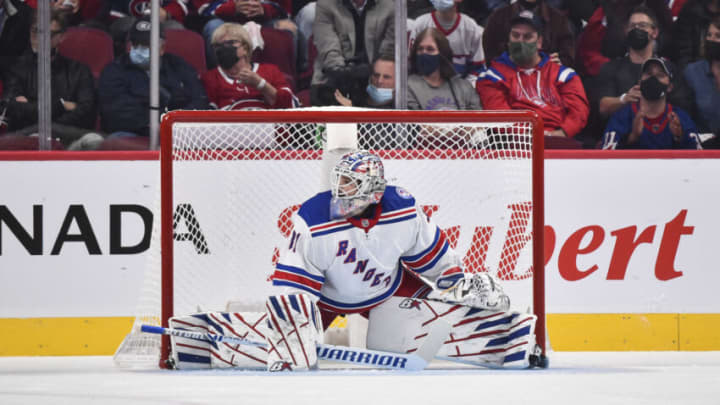If Igor Shesterkin inherited anything from the Henrik Lundqvist era, it’s the undying responsibility of bailing the New York Rangers out of embarrassing losses—and further more—manufacturing wins with mediocre offensive production.
For all the glory it brought Lundqvist from having to answer countless bells, it’s something that he’s likely reflecting on with liberating sighs of relief while he now breaks down his successor across the street from MSG as an analyst.
Lundqvist quoted the illustrious Rangers goaltending coach, Benoit Allaire, on a recent segment saying, “Play the game first. Worry about technique later.” In other words, if a goaltender gets too caught up in the nitty gritty of positioning, it becomes a distraction and a subsequent detriment to game performance. However, Shesterkin’s still executed exceptional technique in a whirlwind of situations.
The 25-year-old has been nothing short of sensational thus far—sporting a 1.85 GAA and .924 SV% through eight games. He’s showed immense poise through shooting clinics that feature odd-man rushes to deflections and prime scoring chances in the slot.
The element of Shesterkin’s game that is most evident is his foot work. At 6’1’’, he isn’t the looming presence that some other NHL goalies can benefit from, but his lateral movement and mobility in the crease is astounding. He transitions from post-to-post with swift efficiency and t-glides square to the puck with perfect execution through all situations. The leg strength in his power slides have been explosive, which has helped him push off from a-to-b to make acrobatic saves off of the rush, or a point-blank stop in the slot when the defense lets one slip by.
He’s also improved his ability to anticipate deflected shots—the most difficult threat to any NHL goalie. It almost looks as if he’s cheating right or left so he can slide to the deflected shot ahead of time, but his puck-tracking is so razor sharp right now, he’s essentially seeing these plays in slow motion.
Of course, the most luxurious utility he has brought to the fold is his decisive puck playing skills. He’s provided a “sixth skater” effect when the Rangers need to play the puck back to Shesterkin as a last refuge. He can clear the zone effectively or send a Hail Mary or two down-rink to someone ahead of the play, which is a style that Lundqvist—for all he was capable of—was never privy to.
However, something interesting that both of them do share is the neat ability to rebound kick saves into open ice. Shesterkin is using the velocity of a low shot during a shooting flurry to kick out pucks into vacant spaces and clear the zone, which is a cerebral intangible for a goaltender.
The only slight flaw has been after he makes a desperation save off a rebound or high scoring opportunity, he’s had some trouble finding the puck through the wickets on several occasions. But his defenders should be picking up that slack; they at least owe him that. We saw this situation with the J.T. Miller overtime goal in Vancouver.
Goaltending is a position that requires tremendous focus, confidence and compete. He seems to be swimming in a comfortable headspace right now and it’s enabling him to use his athleticism and technically-sound game with poise.
Shesterkin was asked in a pre-season press conference what specifically he had improved during the off-season. His response?
“You will see.”
And so far, that we have.
